Review on the Polymeric and Chelate Gel Precursor for Li-Ion Battery Cathode Material Synthesis
Abstract
:1. Introduction
2. Gels Formation via Hydrolysis and Condensation
2.1. Basic Procedure
2.2. Small Molecule Gelators
2.3. Polymeric Gelators
3. Sol–Gel-Derived Cathodes and Associated Electrochemical Performance
3.1. Lithium Nickel Cobalt Manganese Oxide (NCM)
3.2. Lithium Rich Nickel Cobalt Manganese Oxide (LR-NCM)
3.3. Lithium Nickel Cobalt Aluminum Oxide (NCA)
3.4. Lithium Iron Phosphate (LiFePO4)
4. Conclusions and Future Direction
Author Contributions
Funding
Data Availability Statement
Acknowledgments
Conflicts of Interest
References
- Deng, B.; Wang, Z.; Chen, W.; Li, J.T.; Luong, D.X.; Carter, R.A.; Gao, G.; Yakobson, B.I.; Zhao, Y.; Tour, J.M. Phase controlled synthesis of transition metal carbide nanocrystals by ultrafast flash Joule heating. Nat. Commun. 2022, 13, 262. [Google Scholar] [CrossRef] [PubMed]
- Li, F.; Sun, S.-K.; Chen, Y.; Naka, T.; Hashishin, T.; Maruyama, J.; Abe, H. Bottom-up synthesis of 2D layered high-entropy transition metal hydroxides. Nanoscale Adv. 2022, 4, 2468–2478. [Google Scholar] [CrossRef] [PubMed]
- Luc, W.; Jiao, F. Synthesis of Nanoporous Metals, Oxides, Carbides, and Sulfides: Beyond Nanocasting. Acc. Chem. Res. 2016, 49, 1351–1358. [Google Scholar] [CrossRef] [PubMed]
- Ahmed, B.; Jo, H.; Yoon, S.W.; Choi, K.-Y.; Chen, W.; Chou, F.; Ok, K.M. Mixed Transition Metal (Oxy)fluoride Paramagnet Chains: Synthesis, Structure, and Characterization. Eur. J. Inorg. Chem. 2019, 2019, 3112–3119. [Google Scholar] [CrossRef]
- Bianchini, M.; Wang, J.; Clément, R.J.; Ouyang, B.; Xiao, P.; Kitchaev, D.; Shi, T.; Zhang, Y.; Wang, Y.; Kim, H.; et al. The interplay between thermodynamics and kinetics in the solid-state synthesis of layered oxides. Nat. Mater. 2020, 19, 1088–1095. [Google Scholar] [CrossRef]
- Chamorro, J.R.; McQueen, T.M. Progress toward Solid State Synthesis by Design. Acc. Chem. Res. 2018, 51, 2918–2925. [Google Scholar] [CrossRef]
- Dudina, D.V.; Bokhonov, B.B. Materials Development Using High-Energy Ball Milling: A Review Dedicated to the Memory of M.A. Korchagin. J. Compos. Sci. 2022, 6, 188. [Google Scholar] [CrossRef]
- Islam, M.; Ur, S.C.; Yoon, M.S. Improved performance of porous LiFePO4/C as lithium battery cathode processed by high energy milling comparison with conventional ball milling. Curr. Appl. Phys. 2015, 15, 541–546. [Google Scholar] [CrossRef]
- Cushing, B.L.; Kolesnichenko, V.L.; O’Connor, C.J. Recent advances in the liquid-phase syntheses of inorganic nanoparticles. Chem. Rev. 2004, 104, 3893–3946. [Google Scholar] [CrossRef]
- Kakihana, M. “Sol-Gel” preparation of high temperature superconducting oxides. J. Sol-Gel Sci. Technol. 1996, 6, 7–55. [Google Scholar] [CrossRef]
- Siebert, J.P.; Juelsholt, M.; Günzing, D.; Wende, H.; Ollefs, K.; Birkel, C.S. Towards a mechanistic understanding of the sol-gel syntheses of ternary carbides. Inorg. Chem. Front. 2022, 9, 1565–1574. [Google Scholar] [CrossRef]
- Hench, L.L.; West, J.K. The Sol-Gel Process. Chem. Rev. 1990, 90, 33–72. [Google Scholar] [CrossRef]
- Nyamaa, O.; Kang, G.H.; Huh, S.C.; Yang, J.H.; Nam, T.H.; Noh, J.P. Unraveling the Mechanism and Practical Implications of the Sol-Gel Synthesis of Spinel LiMn2O4 as a Cathode Material for Li-Ion Batteries: Critical Effects of Cation Distribution at the Matrix Level. Molecules 2023, 28, 3489. [Google Scholar] [CrossRef] [PubMed]
- Deng, H.; Aifantis, K.E. Applications of Lithium Batteries. In Rechargeable Ion Batteries: Materials, Design and Applications of Li-Ion Cells and Beyond, 1st ed.; Kumar, R., Aifantis, K., Hu, P., Eds.; Wiley-VCH: Weinheim, Germany, 2022; Volume 4, pp. 83–103. [Google Scholar]
- Masias, A.; Marcicki, J.; Paxton, W.A. Opportunities and Challenges of Lithium-Ion batteries in Automotive Applications. ACS Energy Lett. 2021, 6, 621–630. [Google Scholar] [CrossRef]
- Megahed, S.; Scrosati, B. Lithium-ion rechargeable batteries. J. Power Sources 1994, 51, 79–104. [Google Scholar] [CrossRef]
- Grey, C.P.; Hall, D.S. Prospects for lithium-ion batteries and beyond—A 2030 vision. Nat. Commun. 2020, 11, 2–5. [Google Scholar] [CrossRef]
- Hou, J.; Yang, M.; Wang, D.; Zhang, J. Fundamentals and Challenges of Lithium-Ion Batteries at Temperatures between 40 and 60 °C. Adv. Energy Mater. 2020, 10, 1904152. [Google Scholar] [CrossRef]
- Deng, D. Li-ion batteries: Basics, progress, and challenges. Energy Sci. Eng. 2015, 3, 385–418. [Google Scholar] [CrossRef]
- Fu, W.; Wang, Y.; Kong, K.; Kim, D.; Wang, F.; Yushin, G. Materials and Processing of Lithium-Ion Battery Cathodes. Nanoenergy Adv. 2023, 3, 138–154. [Google Scholar] [CrossRef]
- Eshetu, G.G.; Zhang, H.; Judez, X.; Adenusi, H.; Armand, M.; Passerini, S.; Figgemeier, E. Production of high-energy Li-ion batteries comprising silicon-containing anodes and insertion-type cathodes. Nat. Commun. 2021, 12, 5459. [Google Scholar] [CrossRef]
- Zhao, G.; Wang, X.; Negnevitsky, M. Connecting battery technologies for electric vehicles from battery materials to management. iScience 2022, 25, 103744. [Google Scholar] [CrossRef] [PubMed]
- Abdel-Ghany, A.; El-Tawil, R.S.; Hashem, A.M.; Mauger, A.; Julien, C.M. Improved electrochemical performance of LiNi0.5Mn0.5O2 by Li-enrichment and AlF3 coating. Materialia 2019, 5, 100207. [Google Scholar] [CrossRef]
- Tsai, S.Y.; Fung, K.Z. Synthesis Routes on Electrochemical Behavior of Co-Free Layered LiNi0.5Mn0.5O2 Cathode for Li-Ion Batteries. Molecules 2023, 28, 794. [Google Scholar] [CrossRef]
- Yi, H.; Liang, Y.; Qian, Y.; Feng, Y.; Li, Z.; Zhang, X. Low-Cost Mn-Based Cathode Materials for Lithium-Ion Batteries. Batteries 2023, 9, 246. [Google Scholar] [CrossRef]
- Vernardou, D. Recent Report on the Hydrothermal Growth of LiFePO4 as a Cathode Material. Coatings 2022, 12, 1543. [Google Scholar] [CrossRef]
- Liu, Y.; Zhang, J.; Li, Y.; Hu, Y.; Li, W.; Zhu, M.; Hu, P.; Chou, S.; Wang, G. Solvothermal synthesis of a hollow micro-sphere LiFePO4/C composite with a porous interior structure as a cathode material for lithium-ion batteries. Nanomaterials 2017, 7, 368. [Google Scholar] [CrossRef]
- Taniguchi, I.; Fukuda, N.; Konarova, M. Synthesis of spherical LiMn2O4 microparticles by a combination of spray pyrolysis and drying method. Powder Technol. 2008, 81, 228–236. [Google Scholar] [CrossRef]
- Cho, T.H.; Chung, H.T. Synthesis of olivine-type LiFePO4 by emulsion-drying method. J. Power Sources 2004, 133, 272–276. [Google Scholar] [CrossRef]
- Myung, S.T.; Kumagai, N.; Komaba, S.; Chung, H.T. Preparation and electrochemical characterization of LiCoO2 by the emulsion drying method. J. Appl. Electrochem. 2000, 30, 1081–1085. [Google Scholar] [CrossRef]
- Islam, M.; Yoon, M.S.; Park, Y.M.; Ur, S.C. Solid state synthesis of LiFePO4/C: Using low-cost materials. J. Ceram. Process. Res. 2015, 16, 218–222. [Google Scholar]
- Wang, L.; Shi, Q.; Zhan, C.; Liu, G. One-Step Solid-State Synthesis of Ni-Rich Cathode Materials for Lithium-Ion Batteries. Materials 2023, 16, 3079. [Google Scholar] [CrossRef] [PubMed]
- Ahn, W.; Lim, S.N.; Jung, K.-N.; Yeon, S.-H.; Kim, K.-B.; Song, H.S.; Shin, K.-H. Combustion-synthesized LiNi0.6Mn0.2Co0.2O2 as cathode material for lithium-ion batteries. J. Alloys Compd. 2014, 609, 143–149. [Google Scholar] [CrossRef]
- Sun, Z.; Zhang, Z.; Li, H. Templated synthesis of nano-LiCoO2 cathode for lithium-Ion batteries with enhanced rate capability. Mater. Lett. 2021, 303, 130570. [Google Scholar] [CrossRef]
- Dong, H.; Koenig, G.M. A review on synthesis and engineering of crystal precursors produced: Via coprecipitation for multicomponent lithium-ion battery cathode materials. Cryst. Eng. Comm. 2020, 22, 1514–1530. [Google Scholar] [CrossRef]
- Pardikar, K.; Entwistle, J.; Ge, R.; Cumming, D.; Smith, R. Status and outlook for lithium-ion battery cathode material synthesis and the application of mechanistic modeling. J. Phys. Energy 2023, 5, 022002. [Google Scholar] [CrossRef]
- Ren, D.; Shen, Y.; Yang, Y.; Shen, L.; Levin, B.D.A.; Yu, Y.; Muller, D.A.; Abruña, H.D. Systematic Optimization of Battery Materials: Key Parameter Optimization for the Scalable Synthesis of Uniform, High-Energy, and High Stability LiNi0.6Mn0.2Co0.2O2 Cathode Material for Lithium-Ion Batteries. ACS Appl. Mater. Interfaces 2017, 9, 35811–35819. [Google Scholar] [CrossRef] [PubMed]
- Malik, M.; Chan, K.H.; Azimi, G. Review on the synthesis of LiNixMnyCo1-x-yO2 (NMC) cathodes for lithium-ion batteries. Mater. Today Energy 2022, 28, 101066. [Google Scholar] [CrossRef]
- Schubert, U. Chemistry and Fundamentals of the Sol–Gel Process. In Synthesis of Inorganic Materials, 3rd ed.; Levy, D., Zayat, M., Eds.; VCH-Wiley Verlag GmbH: Weinheim, Germany, 2015; Chapter 1; pp. 1–28. [Google Scholar]
- Livage, J. Basic Principles of Sol-Gel Chemistry. In Sol-Gel Technologies for Glass Producers and Users; Aegerter, M.A., Mennig, M., Eds.; Springer: Boston, MA, USA, 2004. [Google Scholar]
- Brinker, C.J.; Scherer, G.W. Sol-Gel Science: The Physics and Chemistry of Sol-Gel Processing; Academic Press: London, UK, 1990. [Google Scholar]
- Bhuyan, M.M.; Jophous, M.; Jeong, J.H. Preparation of Pectin–Acrylamide–(Vinyl phosphonic acid) hydrogel and its selective adsorption of metal ions. Polym. Bull. 2023, 80, 4625–4641. [Google Scholar]
- Moreno, Y.P.; Cardoso, M.B.; Ferrao, M.F.; Moncada, E.A.; Dos Santos, J.H.Z. Effect of SiCl4 on the preparation off functionalized mixed-structure silica from monodisperse sol-gel silica nanoparticles. Chem. Eng. J. 2016, 292, 233–245. [Google Scholar] [CrossRef]
- Okumoto, S.; Fujita, N.; Yamabe, S. Theoretical study of hydrolysis and condensation of silicon alkoxides. J. Phys. Chem. A 1998, 102, 3991–3998. [Google Scholar] [CrossRef]
- Cheng, X.; Chen, D.; Liu, Y. Mechanisms of silicon alkoxide hydrolysis-oligomerization reactions: A DFT investigation. Chem. Phys. Chem. 2012, 13, 2392–2404. [Google Scholar] [CrossRef] [PubMed]
- Soloviev, A.; Tufeu, R.; Sanchez, C.; Kanaev, A.V. Nucleation stage in the Ti(OPri)4 sol-gel process. J. Phys. Chem. B 2001, 105, 4175–4180. [Google Scholar] [CrossRef]
- Barlier, V.; Bounor-Legaré, V.; Boiteux, G.; Davenas, J.; Léonard, D. Hydrolysis-condensation reactions of titanium alkoxides in thin films: A study of the steric hindrance effect by X-ray photoelectron spectroscopy. Appl. Surf. Sci. 2008, 254, 5408–5412. [Google Scholar] [CrossRef]
- Guglielmi, M.; Carturan, G. Precursors for sol-gel preparations. J. Non-Cryst. Solids 1988, 100, 16–30. [Google Scholar] [CrossRef]
- Raabe, I.; Wagner, K.; Santiso-Quiñones, G.; Krossing, I. Snapshots of the Hydrolysis of the Lithium Alkoxide [Li{OC(CF3)3}]4. Z. Anorg. Allg. Chem. 2009, 635, 513–517. [Google Scholar] [CrossRef]
- Mäntymäki, M.; Ritala, M.; Leskelä, M. Double metal alkoxides of lithium: Synthesis, structure and applications in materials chemistry. Coord. Chem. Rev. 2012, 256, 854–877. [Google Scholar] [CrossRef]
- Yanovskaya, M.I.; Turevskaya, E.P.; Leonov, A.P.; Ivanov, S.A.; Kolganova, N.V.; Stefanovich, S.Y.; Turova, N.Y.; Venevtsev, Y.N. Formation of LiNbO3 powders and thin films by hydrolysis of metal alkoxides. J. Mater Sci. 1988, 23, 395–399. [Google Scholar] [CrossRef]
- Lithium Alkoxide Electrolyte Additives for Lithium-Ion Cells. Available online: https://www.techbriefs.com/component/content/article/7359-npo-20607 (accessed on 1 June 2001).
- Cruz-Quesada, G.; Espinal-Viguri, M.; López-Ramón, M.V.; Garrido, J.J. Hybrid xerogels: Study of the sol-gel process and local structure by vibrational spectroscopy. Polymers 2021, 13, 2082. [Google Scholar] [CrossRef]
- Bhuyan, M.M.; Jeong, J.H. Synthesis and Characterization of Gamma Radiation Induced Diallyldimethylammonium Chloride-Acrylic Acid-(3-Acrylamidopropyl) Trimethylammonium Chloride Superabsorbent Hydrogel. Gels 2023, 9, 159. [Google Scholar] [CrossRef]
- Sui, R.; Charpentier, P. Synthesis of metal oxide nanostructures by direct sol-gel chemistry in supercritical fluids. Chem. Rev. 2012, 112, 3057–3082. [Google Scholar] [CrossRef]
- Bokov, D.; Jalil, A.T.; Chupradit, S.; Suksatan, W.; Ansari, M.J.; Shewael, I.H.; Valiev, G.H.; Kianfar, E. Nanomaterial by Sol-Gel Method: Synthesis and Application. Adv. Mater. Sci. Eng. 2021, 2021, 5102014. [Google Scholar] [CrossRef]
- Pons, A.; Casas, L.; Estop, E.; Molins, E.; Harris, K.D.M.; Xu, M. A new route to aerogels: Monolithic silica cryogels. J. Non-Cryst. Solids 2012, 358, 461–469. [Google Scholar] [CrossRef]
- Esposito, S. “Traditional” sol-gel chemistry as a powerful tool for the preparation of supported metal and metal oxide catalysts. Mater. 2019, 12, 668. [Google Scholar] [CrossRef] [PubMed]
- Livage, J.; Henry, M.; Sanchez, C. Sol-gel chemistry of transition metal oxides. Prog. Solid State Chem. 1988, 18, 259–341. [Google Scholar] [CrossRef]
- Nakajima, K.; Souza, F.L.; Freitas, A.L.M.; Thron, A.; Castro, R.H.R. Improving Thermodynamic Stability of nano-LiMn2O4 for Li-Ion Battery Cathode. Chem. Mater. 2021, 33, 3915–3925. [Google Scholar] [CrossRef]
- Li, W.; Yao, L.; Zhang, X.; Lang, W.; Si, J.; Yang, J.; Li, L. The effect of chelating agent on synthesis and electrochemical properties of LiNi0.6Co0.2Mn0.2O2. SN Appl. Sci. 2020, 2, 554. [Google Scholar] [CrossRef]
- Katelnikovas, A.; Barkauskas, J.; Ivanauskas, F.; Beganskiene, A.; Kareiva, A. Aqueous sol-gel synthesis route for the preparation of YAG: Evaluation of sol-gel process by mathematical regression model. J. Sol-Gel Sci. Technol. 2007, 41, 193–201. [Google Scholar] [CrossRef]
- Courtney, R.C.; Gustafson, R.L.; Chaberek, S.; Martell, A.E. Hydrolytic Tendencies of Metal Chelate Compounds. II. Effect of Metal Ion. J. Am. Chem. Soc. 1958, 80, 2121–2128. [Google Scholar] [CrossRef]
- Flynn, C.M. Hydrolysis of Inorganic Iron(III) Salts. Chem. Rev. 1984, 84, 31–41. [Google Scholar] [CrossRef]
- Hector, A.L. Materials synthesis using oxide free sol–gel systems. Chem. Soc. Rev. 2007, 36, 1745–1753. [Google Scholar] [CrossRef]
- Zhao, L.; Fang, K.; Jiang, D.; Li, D.; Sun, Y. Sol-gel derived Ni-Mo bimetallic carbide catalysts and their performance for CO hydrogenation. Catal. Today 2010, 158, 490–495. [Google Scholar] [CrossRef]
- Giordano, C.; Antonietti, M. Synthesis of crystalline metal nitride and metal carbide nanostructures by sol–gel chemistry. Nanotoday 2011, 6, 366–380. [Google Scholar] [CrossRef]
- Lin, Y.; Välikangas, J.; Sliz, R.; Molaiyan, P.; Hu, T.; Lassi, U. Optimized Morphology and Tuning the Mn3+ Content of LiNi0.5Mn1.5O4 Cathode Material for Li-Ion Batteries. Materials 2023, 16, 3116. [Google Scholar] [CrossRef] [PubMed]
- Song, X.; Jia, M.; Chen, R. Synthesis of Li3VO4 by the citrate sol-gel method and its ionic conductivity. J. Mater. Process. Technol. 2002, 120, 21–25. [Google Scholar] [CrossRef]
- Liu, H.; Li, J.; Zhang, Z.; Gong, Z.; Yang, Y. The effects of sintering temperature and time on the structure and electrochemical performance of LiNi0.8Co0.2O2 cathode materials derived from sol-gel method. J. Solid State Electrochem. 2003, 7, 456–462. [Google Scholar] [CrossRef]
- Zhang, Y.; Wu, X.; Lin, Y.; Wang, D.; Zhang, C.; He, D. Synthesis of LiNi1/3Co1/3Mn1/3O2 cathode material by a modified sol-gel method for lithium-ion battery. J. Sol-Gel. Sci. Technol. 2013, 68, 169–174. [Google Scholar] [CrossRef]
- Wen, W.; Wu, J.M. Nanomaterials via solution combustion synthesis: A step nearer to controllability. RSC Adv. 2014, 4, 58090–58100. [Google Scholar] [CrossRef]
- Yue, Z.; Zhou, J.; Li, L.; Zhang, H.; Gui, Z. Synthesis of nanocrystalline NiCuZn ferrite powders by sol-gel auto-combustion method. J. Magn. Magn. Mater. 2000, 208, 55–60. [Google Scholar] [CrossRef]
- Deganello, F.; Marcì, G.; Deganello, G. Citrate-nitrate auto-combustion synthesis of perovskite-type nanopowders: A systematic approach. J. Eur. Ceram. Soc. 2009, 29, 439–450. [Google Scholar] [CrossRef]
- Li, Y.; Xue, L.; Fan, L.; Yan, Y. The effect of citric acid to metal nitrates molar ratio on sol-gel combustion synthesis of nanocrystalline LaMnO3 powders. J. Alloys Compd. 2009, 478, 493–497. [Google Scholar] [CrossRef]
- Wang, D.; Cao, L.; Huang, J.; Wu, J. Effects of different chelating agents on the composition, morphology and electrochemical properties of LiV3O8 crystallites synthesized via sol-gel method. Ceram. Int. 2013, 39, 3759–3764. [Google Scholar] [CrossRef]
- Danks, A.E.; Hall, S.R.; Schnepp, Z. The evolution of “sol-gel” chemistry as a technique for materials synthesis. Mater. Horizons 2016, 3, 91–112. [Google Scholar] [CrossRef]
- Hsu, K.F.; Tsay, S.Y.; Hwang, B.J. Synthesis and characterization of nano-sized LiFePO4 cathode materials prepared by a citric acid-based sol-gel route. J. Mater. Chem. 2004, 14, 2690–2695. [Google Scholar] [CrossRef]
- Meng, Y.; He, M.; Zeng, Q.; Jiao, D.; Shukla, S.; Ramanujan, R.; Liu, Z. Synthesis of barium ferrite ultrafine powders by a sol-gel combustion method using glycine gels. J. Alloys Compd. 2014, 583, 220–225. [Google Scholar] [CrossRef]
- Sun, S.; Yang, X.; Zhang, Y.; Zhang, F.; Ding, J.; Bao, J.; Gao, C. Enhanced photocatalytic activity of sponge-like ZnFe2O4 synthesized by solution combustion method. Prog Nat. Sci. Mater. Int. 2012, 22, 639–643. [Google Scholar] [CrossRef]
- Zhou, W.; Shao, Z.; Ran, R.; Gu, H.; Jin, W.; Xu, N. LSCF nano-powder from cellulose-glycine-nitrate process and its application in intermediate-temperature solid-oxide fuel cells. J. Am. Ceram. Soc. 2008, 91, 1155–1162. [Google Scholar] [CrossRef]
- Liu, T.; Xu, Y. Synthesis of nanocrystalline LaFeO3 powders via glucose sol-gel route. Mater. Chem. Phys. 2011, 129, 1047–1050. [Google Scholar] [CrossRef]
- Norouzbeigi, R.; Edrissi, M. Preparation of nano alumina powder via combustion synthesis: Porous structure optimization via taguchi L16 design. J. Am. Ceram. Soc. 2011, 94, 4052–4058. [Google Scholar] [CrossRef]
- Osman, N.; Abdul, S.A.; Che, M.A.N.; Abd, M.N.I.; Andas, J. Chelating agent size effect on thermal decomposition, phase formation and morphology characteristics of Y3+ doped Ba(Ce,Zr)O3 ceramics powder prepared by a sol-gel process. Ceram. Int. 2022, 48, 2289–2297. [Google Scholar] [CrossRef]
- Pechini, M.P. Method of Preparing Lead and Alkaline Earth Titanates and Niobates and Coating Method Using the Same to form a Capacitor. U.S. Patent 3330697A, 11 July 1967. [Google Scholar]
- Lin, J.; Yu, M.; Lin, C.; Liu, X. Multiform Oxide Optical Materials via the Versatile Pechini-Type Sol−Gel Process: Synthesis and Characteristics. J. Phys. Chem. C 2007, 111, 5835–5845. [Google Scholar] [CrossRef]
- Rudisill, S.G.; Shaker, S.; Terzic, D.; Le, M.R.; Su, B.L.; Stein, A. Generalized approach to the microstructure direction in metal oxide ceramics via polymerization-induced phase separation. Inorg. Chem. 2015, 54, 993–1002. [Google Scholar] [CrossRef] [PubMed]
- Hayat, K.; Gondal, M.A.; Khaled, M.M.; Ahmed, S.; Shemsi, A.M. Nano ZnO synthesis by modified sol gel method and its application in heterogeneous photocatalytic removal of phenol from water. Appl. Catal. A Gen. 2011, 393, 122–129. [Google Scholar] [CrossRef]
- Jiang, Z.; Chen, S.; Wei, C.; Zhang, Z.; Wu, Z.; Luo, Q.; Ming, L.; Zhang, L.; Yu, C. Enabling superior electrochemical performance of NCA cathode in Li5.5PS4.5Cl1.5-based solid-state batteries with a dual-electrolyte layer. Chin. Chem. Lett. 2024, 35, 108561. [Google Scholar] [CrossRef]
- Kandhasamy, S.; Pandey, A.; Minakshi, M. Polyvinylpyrrolidone assisted sol-gel route LiCo1/3Mn1/3Ni1/3PO4 composite cathode for aqueous rechargeable battery. Electrochim. Acta 2012, 60, 170–176. [Google Scholar] [CrossRef]
- Raj, H.; Sil, A. Effect of carbon coating on electrochemical performance of LiFePO4 cathode material for Li-ion battery. Ionics 2018, 24, 2543–2553. [Google Scholar] [CrossRef]
- Arbia, M.B.; Helal, H.; Comini, E. Recent Advances in Low-Dimensional Metal Oxides via Sol-Gel Method for Gas Detection. Nanomaterials 2024, 14, 359. [Google Scholar] [CrossRef]
- Navas, D.; Fuentes, S.; Castro-Alvarez, A.; Chavez-Angel, E. Review on Sol-Gel Synthesis of Perovskite and Oxide Nanomaterials. Gels 2021, 7, 275. [Google Scholar] [CrossRef]
- Zhu, X.-J.; Chen, H.-H.; Zhan, H.; Liu, H.-X.; Yang, D.-L.; Zhou, Y.-H. Synthesis and Characteristics of LiNi0.85Co0.15O2 Cathode Materials by Particulate Sol-Gel Method for Lithium-Ion Batteries. Chin. J. Chem. 2005, 23, 491–495. [Google Scholar] [CrossRef]
- Liu, H.; Wu, Y.P.; Rahm, E.; Holze, R.; Wu, H.Q. Cathode materials for lithium-ion batteries prepared by sol-gel methods. J. Solid State Eletrochem. 2004, 8, 450–466. [Google Scholar] [CrossRef]
- Pfleging, W. Recent progress in laser texturing of battery materials: A review of tuning electrochemical performances, related material development, and prospects for large-scale manufacturing. Int. J. Extrem. Manuf. 2021, 3, 012002. [Google Scholar] [CrossRef]
- Cao, X.; Zhao, Y.; Zhu, L.; Xie, L.; Cao, X.; Xiong, S.; Wang, C. Synthesis and characterization of LiNi1/3Co1/3Mn1/3O2 as cathode materials for Li-ion batteries via an efficacious sol-gel method. Int. J. Electrochem. Sci. 2016, 11, 5267–5278. [Google Scholar] [CrossRef]
- Zhu, L.; Yang, G.; Liu, J.; Bao, C.; Xie, L.; Cao, X. Ethylene Glycol-Assisted Sol-Gel Method for Preparing LiNi1/3Co1/3Mn1/3O2 as Cathode Material for Lithium-Ion Batteries with Excellent Electrochemical Performance. Chem. Sel. 2019, 4, 11475–11482. [Google Scholar] [CrossRef]
- Sun, G.; Jia, C.; Zhang, J.; Yang, W.; Ma, Z.; Shao, G.; Qin, X. Effectively enhance high voltage stability of LiNi1/3Co1/3Mn1/3O2 cathode material with excellent energy density via La2O3 surface modified. Ionics 2019, 25, 2007–2016. [Google Scholar] [CrossRef]
- Yang, X.; Bao, C.; Xie, L.; Zhu, L.; Cao, X. Preparation of LiNi1/3Co1/3Mn1/3O2/polytriphenylamine cathode composites with enhanced electrochemical performances towards reversible lithium storage. Ceram. Int. 2019, 45, 9726–9735. [Google Scholar] [CrossRef]
- Mallick, S.; Patel, A.; Sun, X.-G.; Paranthaman, M.P.; Mou, M.; Mugumya, J.H.; Jiang, M.; Rasche, M.L.; Lopez, H.; Gupta, R.B. Low-cobalt active cathode materials for high-performance lithium-ion batteries: Synthesis and performance enhancement methods. J. Mater. Chem A 2023, 11, 3789–3821. [Google Scholar] [CrossRef]
- Cho, H.; Kim, J.; Kim, M.; An, H.; Min, K.; Park, K. A review of problems and solutions in Ni-rich cathode-based Li-ion batteries from two research aspects: Experimental studies and computational insights. J. Power Sources 2024, 597, 234132. [Google Scholar] [CrossRef]
- Mou, M.; Patel, A.; Mallick, S.; Thapaliya, B.P.; Paranthaman, M.P.; Mugumya, J.H.; Rasche, M.L.; Gupta, R.B.; Saleh, S.; Kothe, S.; et al. Scalable Advanced Li(Ni0.8Co0.1Mn0.1)O2 Cathode Materials from a Slug Flow Continuous Process. ACS Omega 2022, 7, 42408–42417. [Google Scholar] [CrossRef]
- Jones, N. The new car batteries that could power the electric vehicle revolution. Nature 2024, 626, 248–251. [Google Scholar] [CrossRef]
- Lu, H.; Zhou, H.; Svensson, A.M.; Fossdal, A.; Sheridan, E.; Lu, S.; Vullum-Bruer, F. High capacity Li[Ni0.8Co0.1Mn0.1]O2 synthesized by sol-gel and co-precipitation methods as cathode materials for lithium-ion batteries. Solid State Ion. 2013, 249–250, 105–111. [Google Scholar] [CrossRef]
- Jiang, D.; Zhao, L.; Shao, Y.; Wang, D. Preparation and characterization of layered LiNi0.9Co0.05Mn0.025Mg0.025O2 cathode material by a sol-gel method for lithium-ion batteries. RSC Adv. 2015, 5, 40779–40784. [Google Scholar] [CrossRef]
- Guo, J.; Li, W. Synthesis of Single-Crystal LiNi0.7Co0.15Mn0.15O2 Materials for Li-Ion Batteries by a Sol-Gel Method. ACS Appl. Energy Mater. 2022, 5, 397–406. [Google Scholar] [CrossRef]
- Wu, Y.; Li, M.; Wahyudi, W.; Sheng, G.; Miao, X.; Anthopoulos, T.D.; Huang, K.-W.; Li, Y.; La, Z. Performance and Stability Improvement of Layered NCM Lithium-Ion Batteries at High Voltage by a Microporous Al2O3 Sol-Gel Coating. ACS. Omega 2019, 4, 13972–13980. [Google Scholar] [CrossRef] [PubMed]
- Deng, X.; Zhang, R.; Zhou, K.; Gao, Z.; He, W.; Zhang, L.; Han, C.; Kang, F.; Li, B. A Comparative Investigation of Single Crystal and Polycrystalline Ni-Rich NCMs as Cathodes for Lithium-Ion Batteries. Energy Environ. Mater. 2023, 6, e12331. [Google Scholar] [CrossRef]
- Hamad, K.I.; Xing, Y. Effect of Cobalt and Nickel Contents on the Performance of Lithium Rich Materials Synthesized in Glycerol Solvent. J. Electrochem. Soc. 2018, 165, A2470–A2475. [Google Scholar] [CrossRef]
- Ma, Z.; Shao, G.; Fan, Y.; Wang, G.; Song, J.; Liu, T. Tunable Morphology Synthesis of LiFePO4 Nanoparticles as Cathode Materials for Lithium Ion Batteries. ACS Appl. Mater. Interfaces 2014, 6, 9236. [Google Scholar] [CrossRef]
- Chen, C.; Wu, H.; Zhou, D.; Xu, D.; Zhou, Y.; Guo, J. Sol-gel synthesis of nano Li1.2Mn0·54Ni0·13Co0·13O2 cathode materials using DL-lactic acid as chelating agent. Ceram. Int. 2021, 47, 6270–6278. [Google Scholar] [CrossRef]
- Zheng, J.M.; Wu, X.B.; Yang, Y. A comparison of preparation method on the electrochemical performance of cathode material Li[Li0.2Mn0.54Ni0.13Co0.13]O2 for lithium ion battery. Electrochim. Acta 2011, 56, 3071–3078. [Google Scholar] [CrossRef]
- Nisar, U.; Amin, R.; Shakoor, A.; Essehli, R.; Al-Qaradawi, S.; Kahraman, R.; Belharouak, I. Synthesis and electrochemical characterization of Cr-doped lithium-rich Li1.2Ni0.16Mn0.56Co0.08−xCrxO2 cathodes. Emergent Mater. 2018, 1, 155–164. [Google Scholar] [CrossRef]
- Prettencia, L.J.; Soundarrajan, E.; Roselin, R.M.; Kalaivani, R.; Raghu, S. Sol-gel route synthesis of high energy density Li [Li0.2Ni0.3Mn0.7]O2 cathode with controlled structure, morphology and enhanced electrochemical performance. Energy Storage 2023, 5, e427. [Google Scholar]
- Hamad, K.I.; Xing, Y. Improving Retention Rate of LiNi0.8Co0.15Al0.05O2 Cathode Material Synthesized Using Glycerol Solvent. J. Electrochem. Energy Convers. Storage 2020, 17, 031006. [Google Scholar]
- Li, Y.; Yu, H.; Hu, Y.; Jiang, H.; Li, C. Surface-Engineering of Layered LiNi0.815Co0.15Al0.035O2 Cathode Material for High-Energy and Stable Li-Ion Batteries. J. Energy Chem. 2018, 27, 559–564. [Google Scholar]
- Wu, G.; Zhou, Y. TiP2O7-Coated LiNi0.8Co0.15Al0.05O2 Cathode Materials with Improved Thermal Stability and Superior Cycle Life. J. Energy Chem. 2019, 28, 151–159. [Google Scholar]
- Xia, S.; Li, F.; Chen, F.; Guo, H. Preparation of FePO4 by Liquid-Phase Method and Modification on the Surface of LiNi0.80Co0.15Al0.05O2 Cathode Material. J. Alloys Comp. 2018, 731, 428–436. [Google Scholar] [CrossRef]
- Dong, P.; Xia, S.B.; Zhang, Y.J.; Zhang, Y.N.; Qiu, Z.P.; Yao, Y. Influence of complexing agents on the structure and electrochemical properties of LiNi0.80Co0.15Al0.05O2 cathode synthesized by sol-gel method: A comparative study. Int. J. Electrochem. Sci. 2017, 12, 561–575. [Google Scholar]
- Kopuklu, B.B.; Gomez-Martin, A.; Winter, M.; Placke, T.; Schmuch, R.; Gursel, S.A.; Yurum, A. Improved Lithium-Ion Transport Within the LiNi0.8Co0.15Al0.05O2 Secondary Cathode Particles Through a Template-Assisted Synthesis Route. ACS Sustain. Chem. Eng. 2021, 9, 12560–12574. [Google Scholar] [CrossRef]
- He, X.; Xu, X.; Wang, L.; Du, C.; Cheng, X.; Zuo, P.; Ma, Y.; Yin, G. Enhanced Electrochemical Performance of LiNi0.8Co0.15Al0.05O2 Cathode Material via Li2TiO3 Nanoparticles Coating. J. Electrochem. Soc. 2019, 166, A143–A150. [Google Scholar] [CrossRef]
- Padhi, A.K.; Nanjundaswamy, K.S.; Goodenough, J.B. Phospho-olivines as Positive-Electrode Materials for Rechargeable Lithium Batteries. J. Electrochem. Soc. 1997, 144, 1188. [Google Scholar] [CrossRef]
- Zaghib, K.; Mauger, A.; Julien, C.M. Overview of olivines in lithium batteries for green transportation and energy storage. J. Solid State Electrochem. 2012, 16, 835–845. [Google Scholar] [CrossRef]
- Ziolkowska, D.A.; Jasinski, J.B.; Hamankiewicz, B.; Korona, K.P.; Wu, S.H.; Czerwinski, A. In Situ XRD and TEM Studies of Sol-Gel-Based Synthesis of LiFePO4. Cryst Growth Des. 2016, 16, 5006–5013. [Google Scholar] [CrossRef]
- Hadouchi, M.; Koketsu, T.; Hu, Z.; Ma, J. The origin of fast-charging lithium iron phosphate for batteries. Batter. Energy 2022, 1, 20210010. [Google Scholar] [CrossRef]
- Liu, S.; Yin, H.; Wang, H.; Wang, H. Synthesis and characterization of LiFePO4/C cathode materials by sol-gel method. J. Nanosci. Nanotechnol. 2014, 14, 7060–7065. [Google Scholar] [CrossRef] [PubMed]
- Zhang, Y.; Xin, P.; Yao, Q. Electrochemical performance of LiFePO4/C synthesized by sol-gel method as cathode for aqueous lithium-ion batteries. J. Alloys Compd. 2018, 741, 404–408. [Google Scholar] [CrossRef]
- Li, Z.; Dong, G.; Kang, J.; Li, L. Preparation and electrochemical properties of nanoparticle structural LiFePO4/C by Sol–Gel method as cathode material for lithium-ion batteries. J. Mater. Sci. Mater. Electron. 2019, 30, 6593–6600. [Google Scholar] [CrossRef]
- Arbizzani, C.; Beninati, S.; Mastragostino, M. A three-dimensional carbon-coated LiFePO4 electrode for high-power applications. J. Appl. Electrochem. 2010, 40, 7–11. [Google Scholar] [CrossRef]
- Chen, L.; Feng, W.; Su, W.; Li, M.; Song, C. Biosynthesis of LiFePO4/C cathode materials by a sol-gel route for use in lithium-ion batteries. Int. J. Electrochem. Sci. 2019, 14, 2846–2856. [Google Scholar] [CrossRef]
- Choi, D.; Kumta, P.N. Surfactant based sol-gel approach to nanostructured LiFePO4 for high-rate Li-ion batteries. J. Power Sources 2007, 163, 1064–1069. [Google Scholar] [CrossRef]
- Hu, Y.; Doeff, M.M.; Kostecki, R.; Fiñones, R. Electrochemical Performance of Sol-Gel Synthesized LiFePO4 in Lithium Batteries. J. Electrochem. Soc. 2004, 151, A1279. [Google Scholar] [CrossRef]
- Cui, X.; Yi, D.; Li, N.; Zhang, L.; Zhang, X.; Yang, D. Novel LaFeO3 Coating Modification for a LiFePO4 Cathode. Energy Fuels 2020, 34, 7600–7606. [Google Scholar] [CrossRef]
- Xu, Z.; Xu, L.; Lai, Q.; Ji, X. A PEG assisted sol–gel synthesis of LiFePO4 as cathodic material for lithium-ion cells. Mater. Res. Bull. 2007, 42, 883–891. [Google Scholar] [CrossRef]




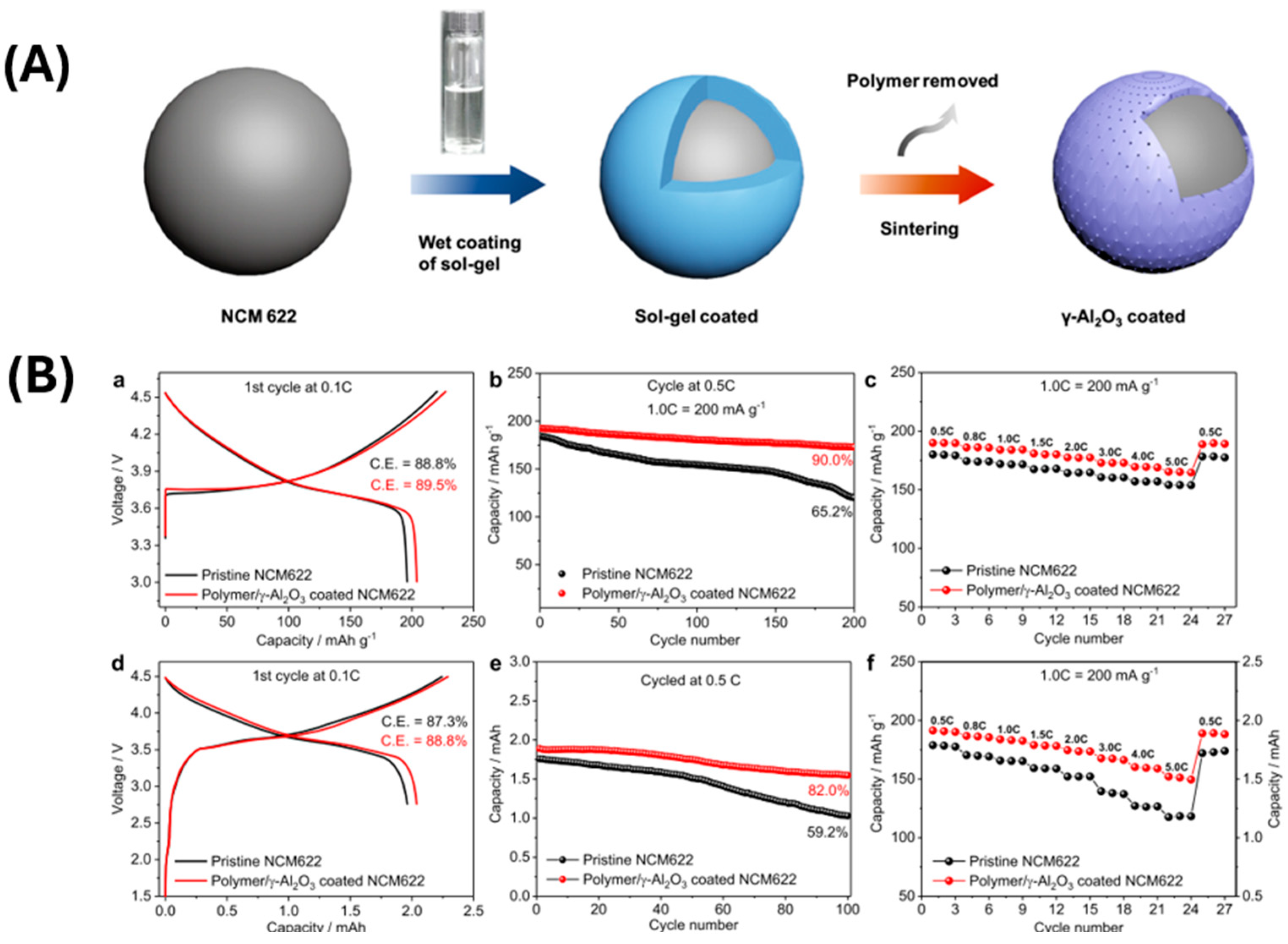

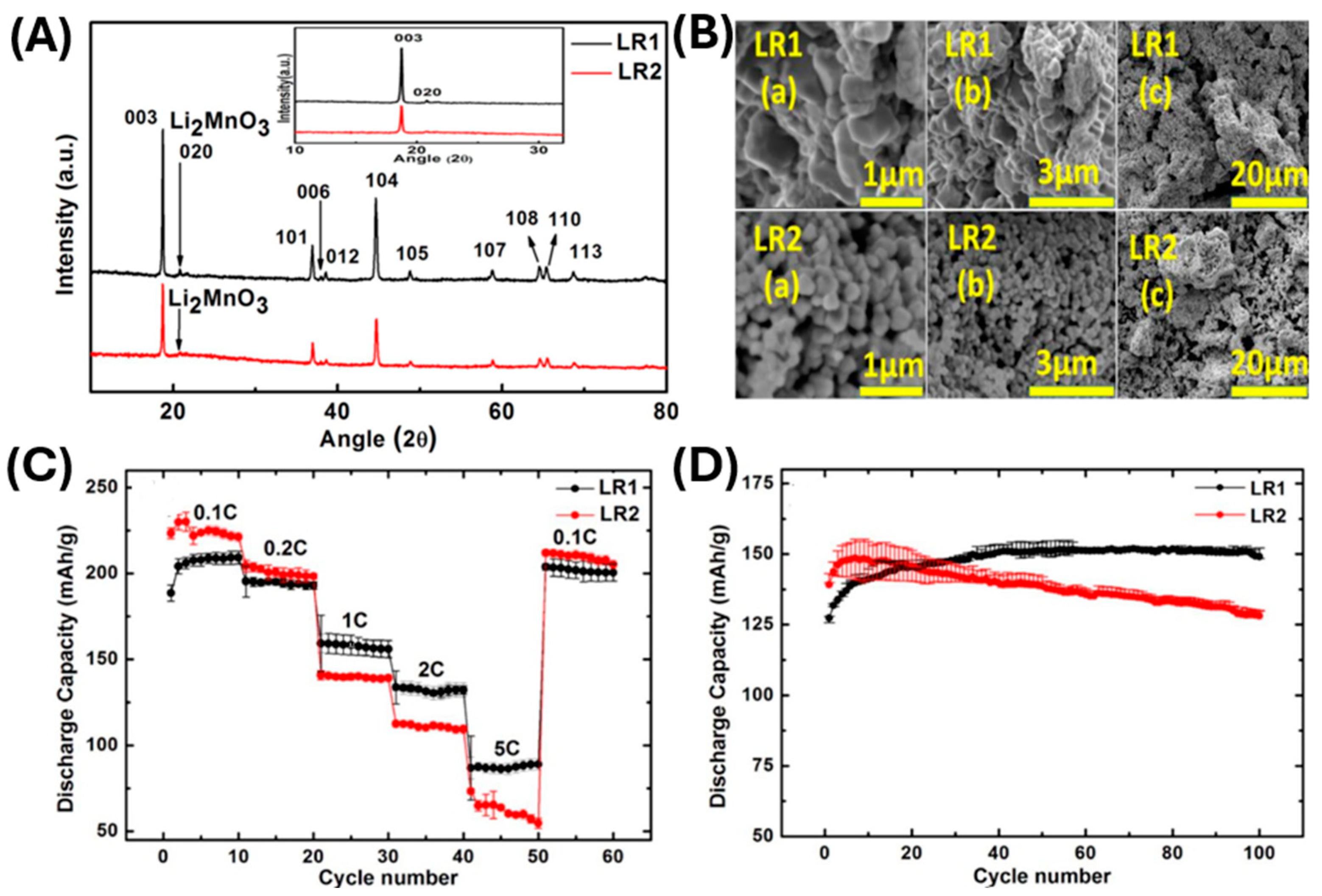

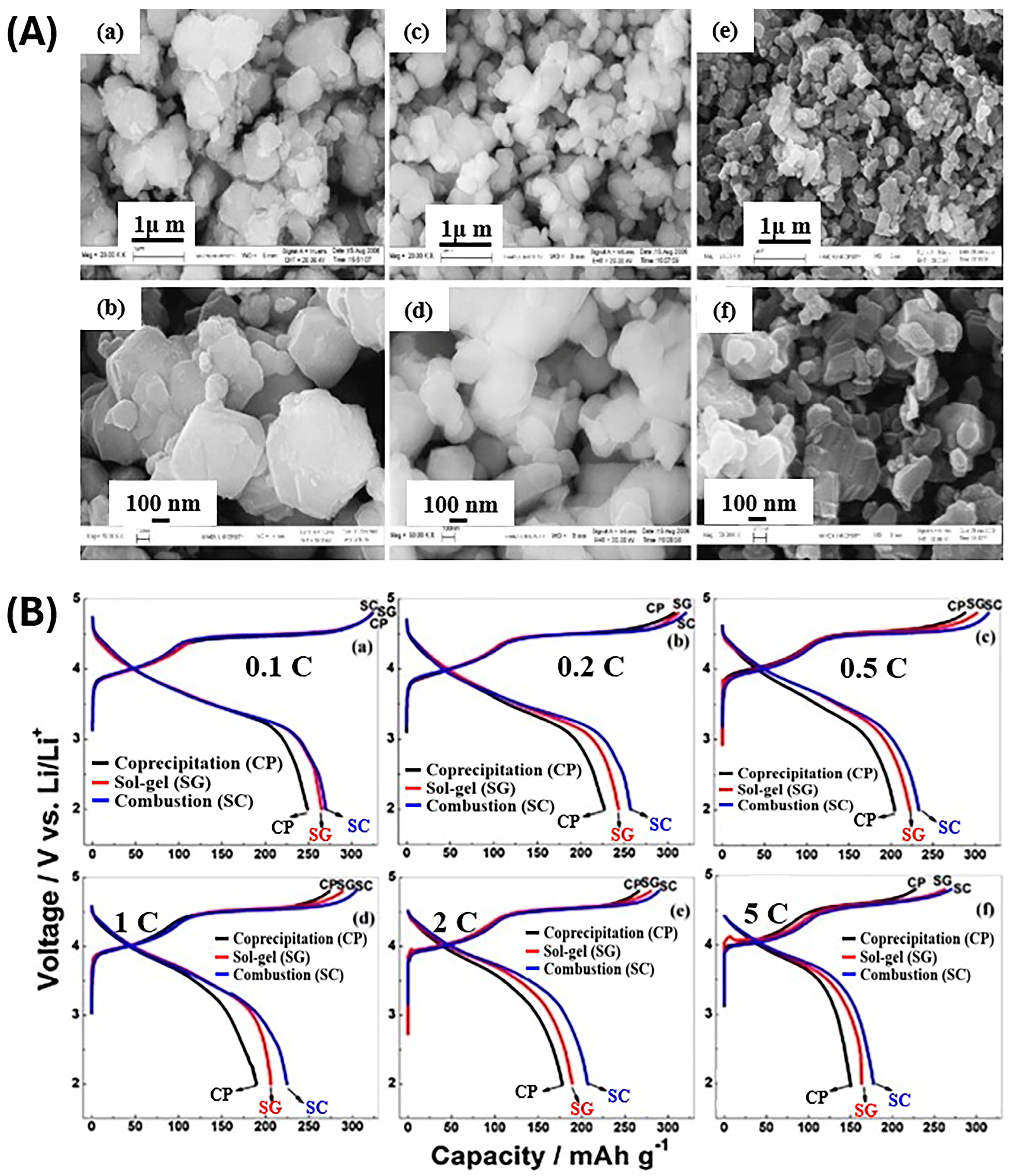
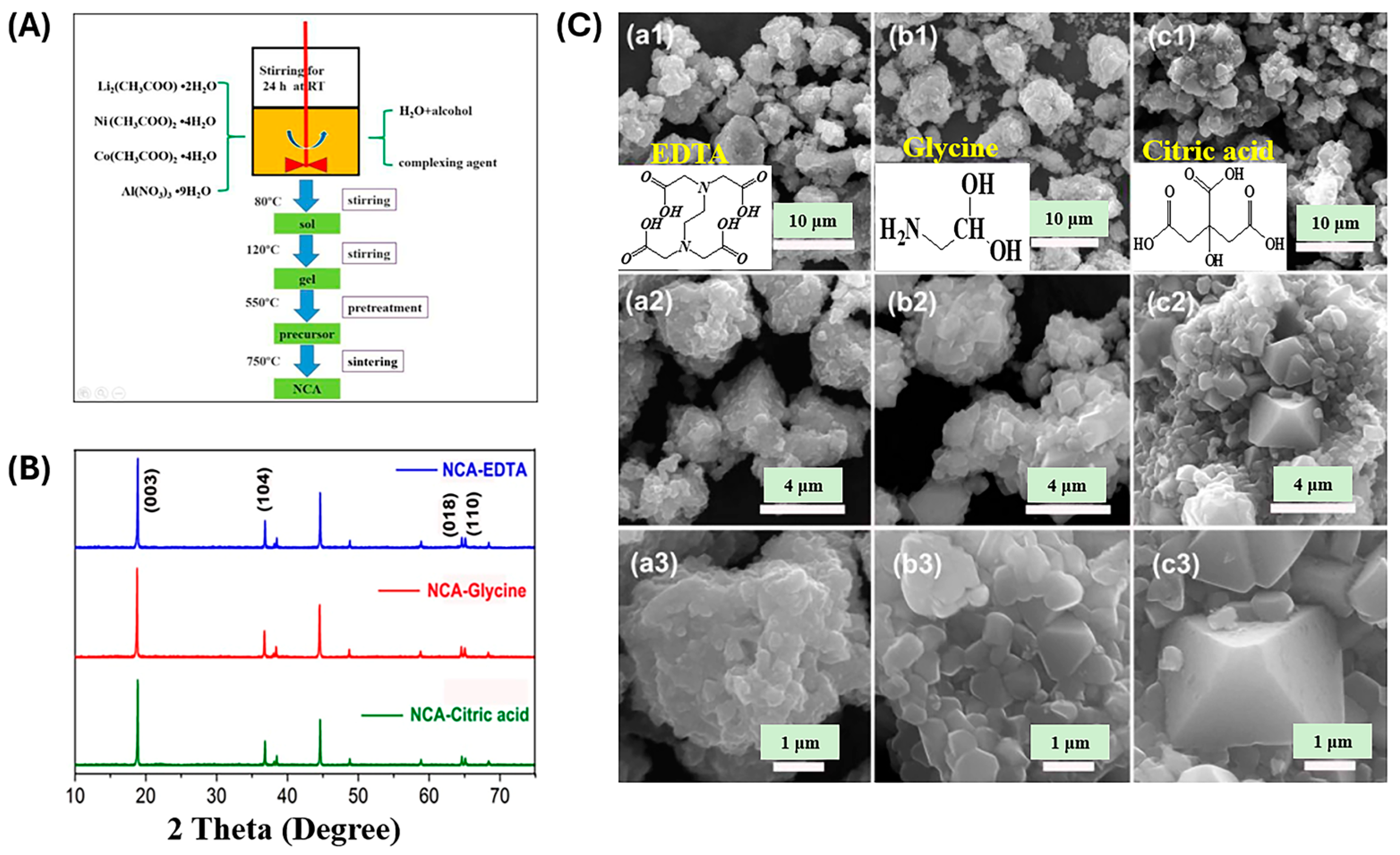

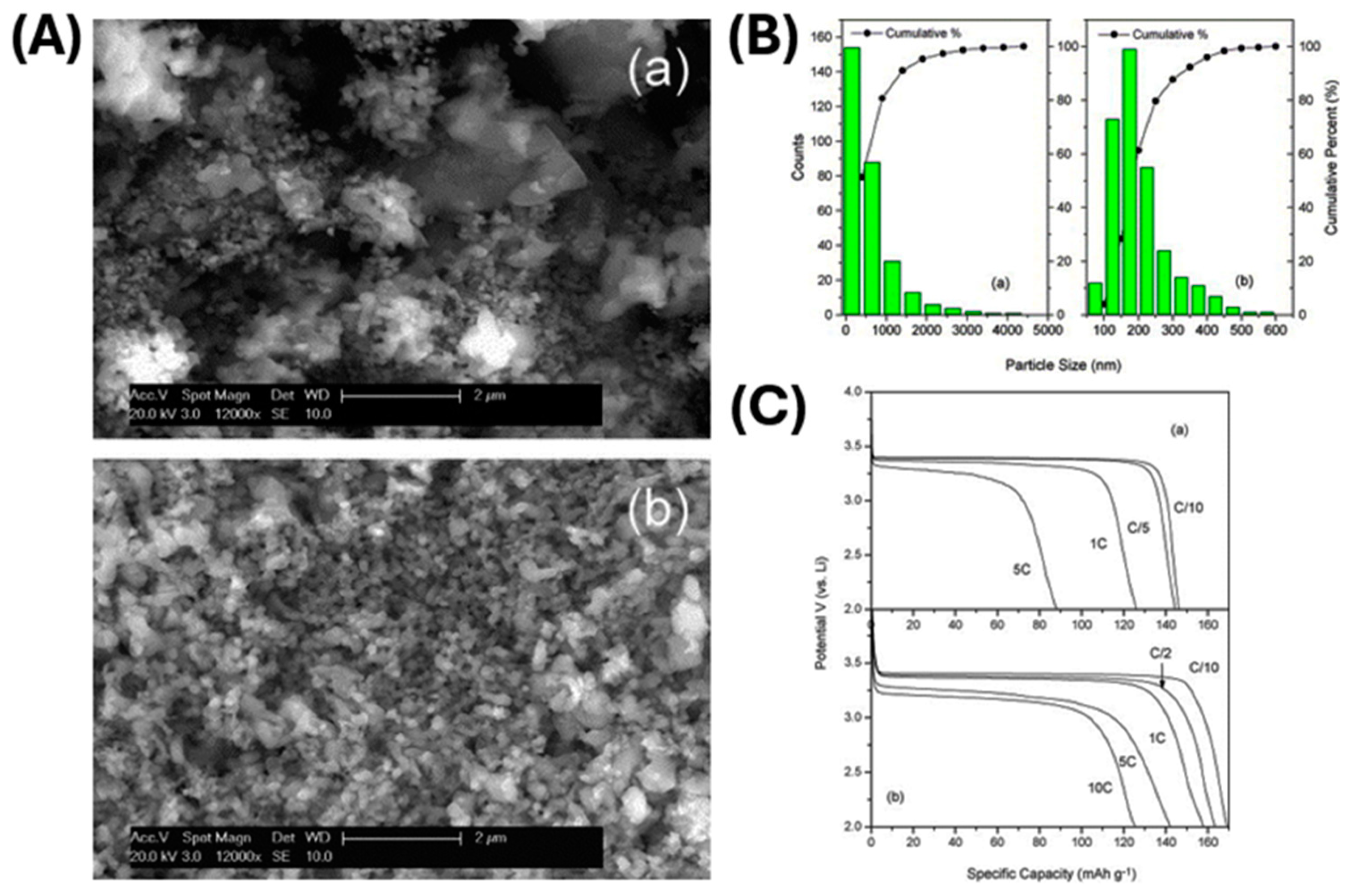


| Cathode | Specific Capacity/Current Rate | Capacity Retention | Rate (mAh g−1) | References |
|---|---|---|---|---|
| LiNi1/3Co1/3Mn1/3O2 | 199.9 mAh g−1/0.1 C | 71.8% @ 80 cycles | ------ | [97] |
| LiNi1/3Co1/3Mn1/3O2 | 208.0 mAh g−1/0.2 C | 66.3% @ 100 cycles | 83.0@5C | [98] |
| LiNi1/3Co1/3Mn1/3O2/PTPAn | 223.7 mAh g−1/0.2 C | 84.3% @ 100 cycles | 127.3@5C | [100] |
| LiNi0.8Co0.1Mn0.1O2 | 200.0 mAh g−1/0.5 C | 75.8% @ 100 cycles | 140.0@5C | [105] |
| LiNi0.9Co0.05Mn0.025Mg0.025O2 | 201.0 mAh g−1/0.1 C | 99.3% @ 10 cycles | 168.0@2C | [106] |
| SC-LiNi0.7Co0.15Mn0.15O2 | 184.6 mAh g−1/0.1 C | 86.3% @ 100 cycles | 171.0@4C | [107] |
| LiNi0.6Co0.2Mn0.2O2/Al2O3 | 203.9 mAh g−1/0.1 C | 90.0% @ 200 cycles | 177.5@5C | [108] |
| Li1.2Mn0.51Ni0.145+xCo0.145-xO2 | 223.0 mAh g−1/0.1 C | 98.0% @ 100 cycles | 89.0@5C | [110] |
| Li1.2Mn0.54Ni0.13Co0.13O2 | 232.3 mAh g−1/0.1 C | 83.9% @ 50 cycles | 120.0@2C | [112] |
| Li[Li0.2Mn0.54Ni0.13Co0.13]O2 | 265.0 mAh g−1/0.1 C | 83.8% @ 30 cycles | 164.0@5C | [113] |
| Li1.2Ni0.16Mn0.56Co0.08−xCrxO2 | 200.0 mAh g−1/0.1 C | 100.0% @ 50 cycles | 150.0@1C | [114] |
| Li[Li0.2Ni0.3Mn0.7]O2 | 308.0 mAh g−1/0.1 C | 99.3% @ 200 cycles | 212.0@2C | [115] |
| LiNi0.8Co0.15Al0.05O2 | 174.8 mAh g−1/0.1 C | 93.6% @ 70 cycles | 105.0@5C | [116] |
| LiNi0.8Co0.15Al0.05O2 | 175.1 mAh g−1/0.2 C | 97.3% @ 30 cycles | 159.8@1C | [120] |
| LiNi0.8Co0.15Al0.05O2 | 169.0 mAh g−1/0.33 C | 60.3% @ 150 cycles | 120.0@10C | [121] |
| LiNi0.8Co0.15Al0.05O2/Li2TiO3 | 191.0 mAh g−1/0.1 C | 96.6% @ 100 cycles | 141.0@5C | [122] |
| Cathode | Specific Capacity/Current Rate | Capacity Retention | Rate (mAh g−1) | References |
|---|---|---|---|---|
| LiFePO4 | 80.0 mAh g−1/0.1 C | ------- | ------ | [125] |
| LiFePO4/C | 150.0 mAh g−1/0.1 C | ------- | ------ | [127] |
| LiFePO4/C | 163.5 mAh g−1/0.1 C | 91.1% @ 110 cycles | 88.4@2C | [128] |
| LiFePO4/C | 156.5 mAh g−1/0.2 C | 96.9% @ 250 cycles | 70.9@10C | [129] |
| LiFePO4/3D-C | 100.0 mAh g−1/1.0 C | 99.0% @ 400 cycles | 85.0@5C | [130] |
| LiFePO4/C | 158.3 mAh g−1/0.1 C | 96.6% @ 100 cycles | 142.0@5C | [131] |
| LiFePO4 | 170.0 mAh g−1/0.1 C | 100.0% @ 30 cycles | 90.0@5C | [132] |
| LiFePO4/C-LaFeO3 | 164.2 mAh g−1/0.1 C | 97.9% @ 100 cycles | 127.3@5C | [134] |
| LiFePO4/C | 162.0 mAh g−1/0.1 C | 99.1% @ 40 cycles | [email protected] | [135] |
Disclaimer/Publisher’s Note: The statements, opinions and data contained in all publications are solely those of the individual author(s) and contributor(s) and not of MDPI and/or the editor(s). MDPI and/or the editor(s) disclaim responsibility for any injury to people or property resulting from any ideas, methods, instructions or products referred to in the content. |
© 2024 by the authors. Licensee MDPI, Basel, Switzerland. This article is an open access article distributed under the terms and conditions of the Creative Commons Attribution (CC BY) license (https://creativecommons.org/licenses/by/4.0/).
Share and Cite
Islam, M.; Ahmed, M.S.; Faizan, M.; Ali, B.; Bhuyan, M.M.; Bari, G.A.K.M.R.; Nam, K.-W. Review on the Polymeric and Chelate Gel Precursor for Li-Ion Battery Cathode Material Synthesis. Gels 2024, 10, 586. https://doi.org/10.3390/gels10090586
Islam M, Ahmed MS, Faizan M, Ali B, Bhuyan MM, Bari GAKMR, Nam K-W. Review on the Polymeric and Chelate Gel Precursor for Li-Ion Battery Cathode Material Synthesis. Gels. 2024; 10(9):586. https://doi.org/10.3390/gels10090586
Chicago/Turabian StyleIslam, Mobinul, Md. Shahriar Ahmed, Muhammad Faizan, Basit Ali, Md Murshed Bhuyan, Gazi A. K. M. Rafiqul Bari, and Kyung-Wan Nam. 2024. "Review on the Polymeric and Chelate Gel Precursor for Li-Ion Battery Cathode Material Synthesis" Gels 10, no. 9: 586. https://doi.org/10.3390/gels10090586











